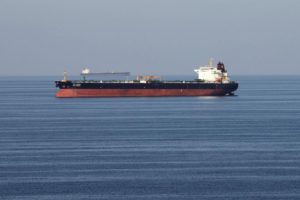 The US Energy Information Administration this week published a very useful guide to flows through the Strait of Hormuz, the channel between the Persian/Arabian Gulf and the Gulf of Oman, which is “the world’s most important oil transit chokepoint”. Last year about 21m barrels a day, about 21 per cent of world petroleum liquids consumption, and about a third of global liquefied natural gas trade, was shipped through the strait. The principal exporters that use it are Saudi Arabia, Iraq, Kuwait, the United Arab Emirates and Iran. The flows increased over the past five years, in particular because of higher exports from Iraq and Iran.
The US Energy Information Administration this week published a very useful guide to flows through the Strait of Hormuz, the channel between the Persian/Arabian Gulf and the Gulf of Oman, which is “the world’s most important oil transit chokepoint”. Last year about 21m barrels a day, about 21 per cent of world petroleum liquids consumption, and about a third of global liquefied natural gas trade, was shipped through the strait. The principal exporters that use it are Saudi Arabia, Iraq, Kuwait, the United Arab Emirates and Iran. The flows increased over the past five years, in particular because of higher exports from Iraq and Iran.
The principal destinations for oil from the Gulf, meanwhile, are in Asia. About 65 per cent of all the crude and condensate passing through the Strait of Hormuz went to just five markets last year: China, India, Japan, South Korea and Singapore. Even though two tankers were attacked in the Gulf of Oman last week, the oil market has generally taken a relatively relaxed view of the threat to global supplies.
The rising tensions in the Gulf have complicated plans for the next meetings of ministers from Opec countries and their allies including Russia. Crown Prince Mohammed bin Salman of Saudi Arabia said last weekend that his kingdom did not want war, “but we will not hesitate to deal with any threat to our people, sovereignty and vital interests”. In that atmosphere, Opec talks with both Iran and Saudi Arabia at the table are bound to be at least a little fraught.
Britain’s renewable energy boom
The milestones have been passing quickly as Britain’s electricity system shifts away from coal and towards renewable energy. In 2017 the country had its first full day without coal-fired power since 1882, then in May this year it had its first week. Then in late May and early June the country went for 18 consecutive days without coal-fired power until the evening of June 4. There was speculation that the return of the popular television show Love Island could have led to a small bump in demand that meant coal generation was needed.
Now Britain is on course for another landmark: this year it is set to generate more of its electricity from zero-carbon sources than from fossil fuels, for the first time since the industrial revolution. National Grid, which owns the electricity transmission system in England and Wales, said that in the first four months of the year, zero-carbon sources — meaning nuclear, hydro, wind and solar — had provided more of Britain’s power than coal and gas, and said it expected that trend to continue for the rest of the year. A chart on the National Grid’s website showed how dramatically the generation mix has changed since 2010. The green line rising is the share of zero-carbon energy, and the falling red line is coal-fired and gas-fired power.
Source: “The Week in Energy: The Oil Chokepoint”, Financial Times
